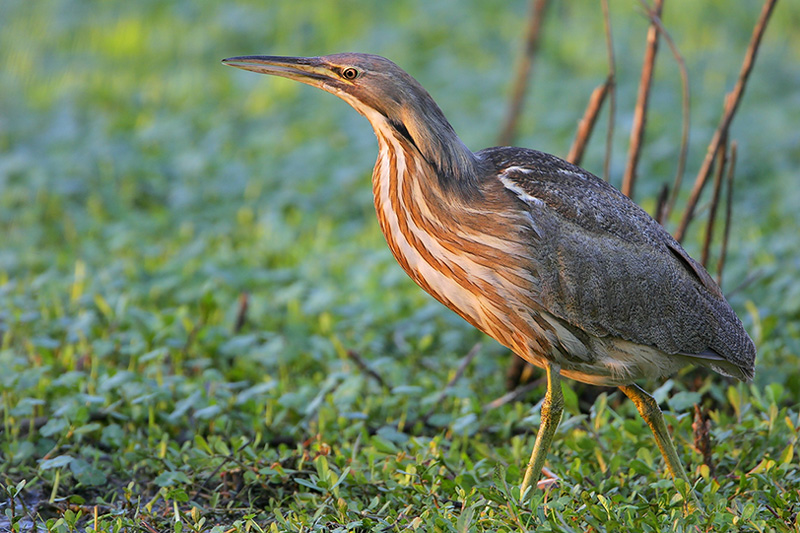
Bitterns are secretive, chunky herons with camouflaged plumage. Unlike other heron species, bitterns don’t want to be seen!
These reclusive birds much prefer to blend in with their surroundings and hide in grassy marshes. Of course that behavior makes them all the more intriguing!
See this article to learn all about the bitterns that call from marshes in North America!
On this page
How Many Bitterns Live In The U.S.?
We find bittern species in most parts of the world, but in the USA, we only have two different species of breeding bitterns. Similar to Eurasia, wetland habitats host one large bittern species and one small bittern species. The big one is the American Bittern, while the smaller bird is the Least Bittern.
Two other bittern species are also on the official bird list for North America, but they are very rare vagrants. These two species are the Little Bittern and the Yellow Bittern. Both are very similar to the Least Bittern and have only occurred as lost migrants in western Alaska.
However, in the meantime, the bitterns we commonly hear and see in the USA are the two breeding species. On account of their shy behavior, American and Least Bitterns can often be a challenge to see. Laying eyes on them typically requires perseverance, knowing where these birds live, and also knowing how to look for them.
We find the American Bittern in various grassy and shrubby wetland habitats in much of central and southern Canada, and in most of the lower 48 states. The Least Bittern lives in similar marsh habitats in parts of southeastern Canada, California, and much of the eastern USA.
American Bittern
Botaurus lentiginosus
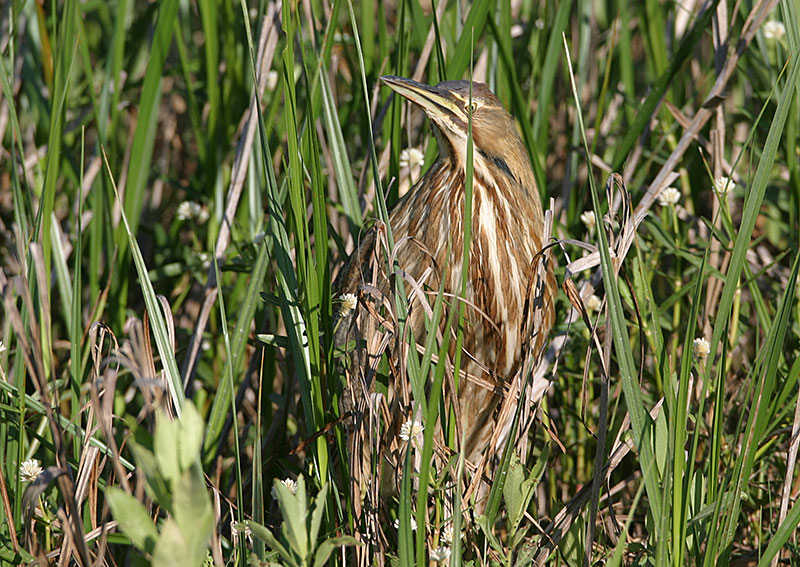
When disturbed, the American Bittern will often stand very still with its bill pointed upward, in imitation of the surrounding reeds. Photo © Sam Crowe
American Bitterns are big, hefty brown herons with a sharp yellowish beak. Both sexes look the same and are around 28 inches long, have a 42 inch wingspan, and weigh 1.5 pounds. These fun heron species also have a white throat, black mustache mark, and thick, red-brown streaks on the front of their long, thick neck.
Unlike other herons, American Bitterns are also stockier birds with much shorter legs. This attribute probably helps them move through and hide in their preferred habitat of dense marsh grass and shrubby wetlands.
Although the American Bittern prefers to hide in dense vegetation, once in a while, they do get up and fly over the marsh. This is actually one of the main ways I see this species. I also occasionally see one standing still at the edge of a marsh, or only see its head as it tries to blend in with the cattails!
This hiding strategy is typical for American Bitterns but can actually help you find them. When frightened or just trying to hide in general, these birds stretch their neck and point their beak up. This really helps them blend in but you can still find them by carefully scanning the top of the marsh grass.
Interestingly, American Bitterns have earned some nicknames, such as Thunder Pumper and Stake Driver, due to their distinctive behavior.
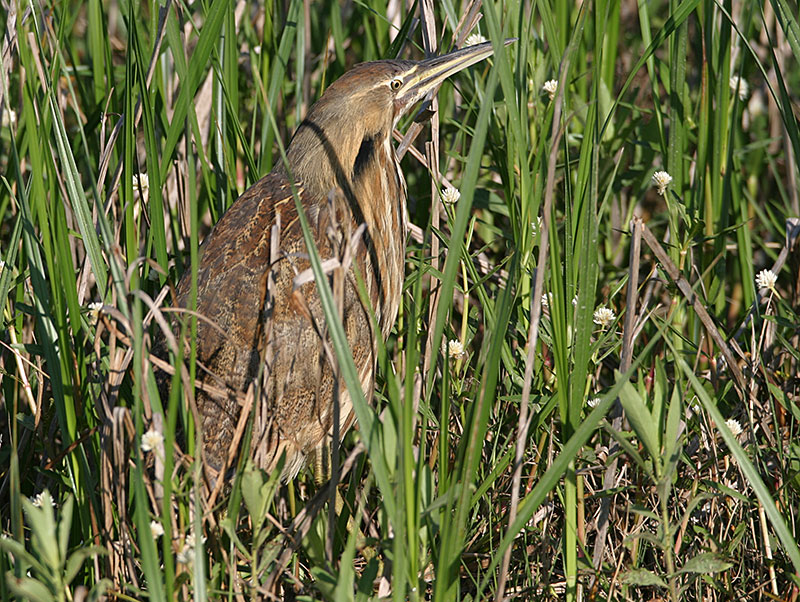
The American Bittern’s profile and color pattern help it bend in with its environment. Photograph © Sam Crowe
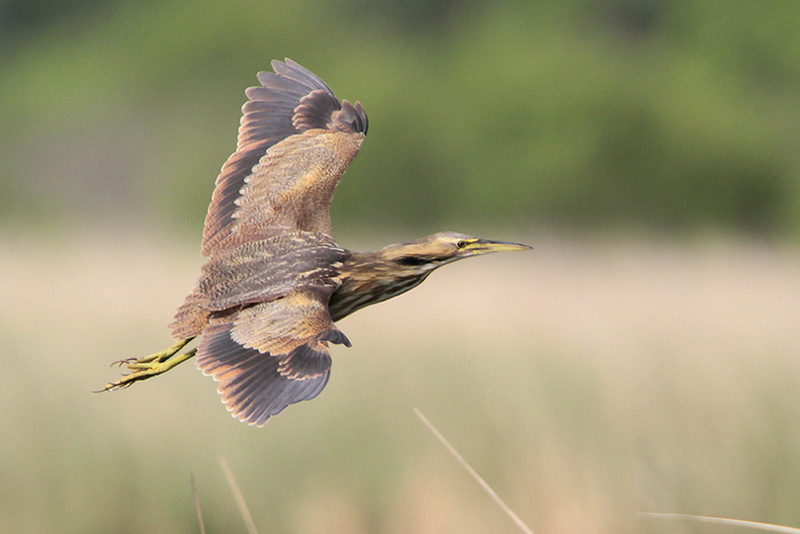
While American Bitterns have a strong affinity for wetland areas they can show up in some strange locations during migration. They also have a very unusual call.
Least Bittern
Ixobrychus exilis
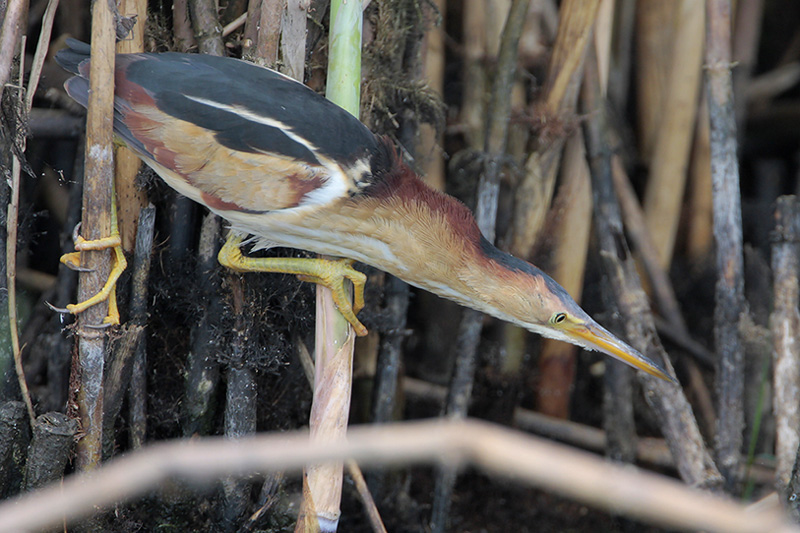
The small Least Bittern can often be observed working the edges of reeds and cattails. Photograph © Greg Lavaty
The Least Bittern is the smallest heron species in North America and one of the smallest herons in the world. Just a bit longer than a foot and with a 17 inch wingspan, this 2.8 ounce heron is about as big as a Northern Flicker!
Males have beige or straw-colored plumage with a neat black cap and a black back and tail. They also have a bit of white on their shoulders, beige streaks on their white throat, white belly, and medium-length yellowish legs.

Juveniles and adults are similar. Juveniles have browner backs and more pattern on the wings. Photograph © Sam Crowe
Female and juveniles look like males with much paler plumage. This species acts a lot like the bigger American Bittern but is even more secretive. Least Bitterns like to skulk in cattail marshes and other wetland habitats.
They can be very difficult to detect, but once in a while, they call from the marsh or suddenly fly over it. When flying, they look like a tiny, yellowish heron with black and buff wings!
When I see a Least Bittern, it’s usually one of those flying birds. However, I also find them by very carefully scanning the edge of a marsh. Once in a while, one of these special little herons materializes in my field of view as it stands very still in the marsh grass.
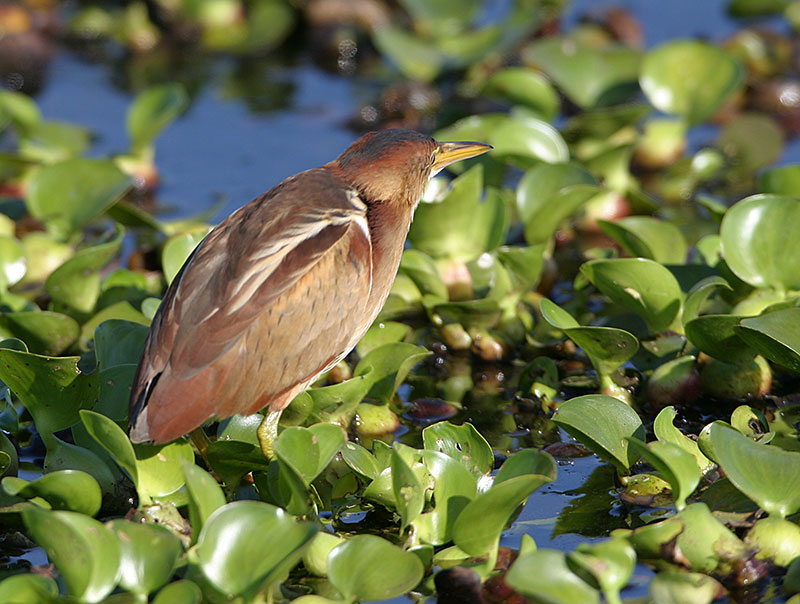
The brown back with pale streaks on the juvenile. Photo © Sam Crowe
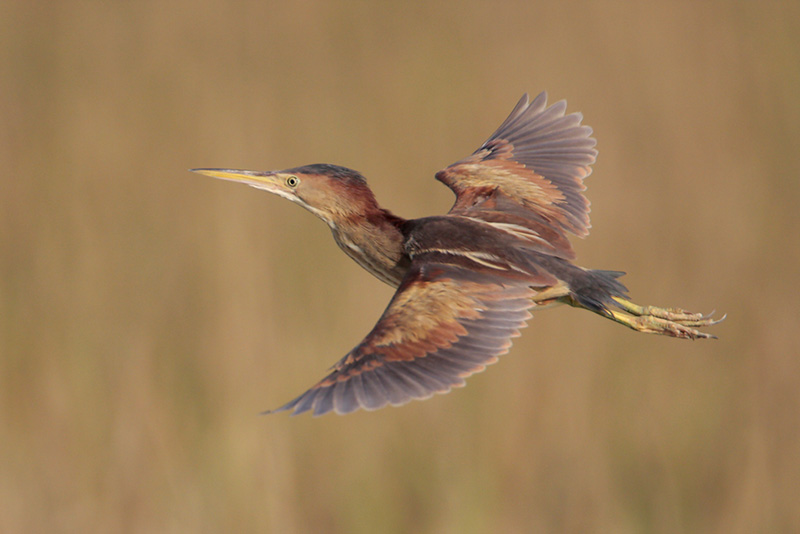
Note the very short tail. Photograph © Greg Lavaty
Are There Any Birds That Look Similar To Bitterns?
Although there are two bitterns in North America, a few other birds can look a bit similar. One of those species is the Green Heron. Like bitterns, this small stocky heron has a thick neck.
It can also act a bit like a bittern; Green Herons often quietly feed in and next to marshes. However, they are still much easier to see than bitterns.
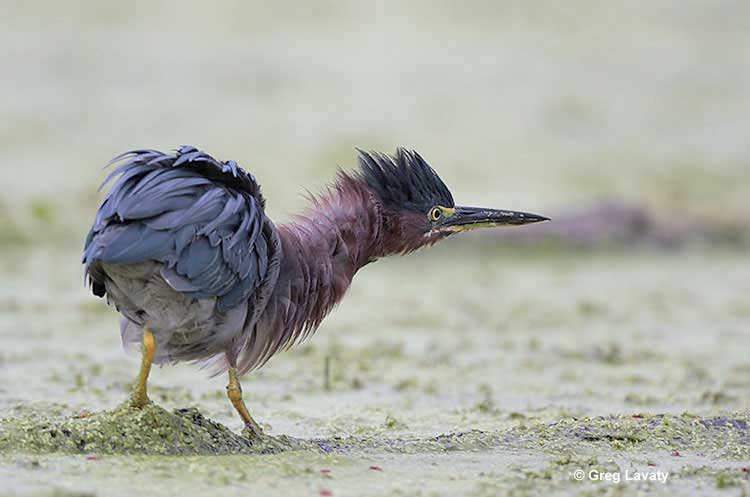
Green Heron
In particular, young Green Herons tend to be confused with bitterns because they have similar dark brown streaks on their neck. However, unlike bitterns, Green Herons always have a dark green back and wings.
Juvenile night-herons can also be confused with bitterns. Young Black-crowned and Yellow-crowned Night-Herons have thick streaks below and their stocky shape can be reminiscent of bittern species.
However, they are even stockier than a bittern, and have shorter beaks and grayer plumage. Night-herons also tend to forage in much more open situations. When they give their distinctive squawking calls, we also know we are definitely dealing with a night-heron and not a bittern!
One other bird that could be confused with a bittern is the similarly shaped Bare-throated Tiger-Heron. It has occurred as a rare vagrant to southern Texas but has different plumage.
Other Bittern Species & Where Can You Find Them
- Little Bittern (Ixobrychus minutus) – Known as the smallest breeding heron in Europe. Native to Europe, Asia and Africa.
- Black-backed Bittern (Ixobrychus dubius) – Also known as Australian Little Bittern, native to eastern and southeastern Australia, but can be found in western areas as well. These birds can be found in New Guinea as well but they do not breed there.
- Cinnamon Bittern (Ixobrychus cinnamomeus) – Native to Asia.
- Stripe-backed Bittern (Ixobrychus involucris) – Located in South America, in northern and southern parts of the continent.
- Yellow Bittern (Ixobrychus sinensis) – Found in Asia and Southeast Asia.
- Schrenck’s Bittern (Ixobrychus eurhythmus) – Located in Asia, ranging from parts of Russia down to Indonesia.
- Dwarf Bittern (Ixobrychus sturmii) – This species is native to Africa.
- Black Bittern (Ixobrychus flavicollis) – Can be found in different parts of Asia and Australia.
- Eurasian Bittern (Botaurus stellaris) – Looks-wise, they are really similar to American Bitterns, but are native to Eurasia. They breed there but migrate to Africa and southern parts of Asia for winter.
- Pinnated Bittern (Botaurus pinnatus) – Also known as South American bittern. Can be found in different areas in South America and Central America.
- Australasian Bittern (Botaurus poiciloptilus) – Also known as the Brown Bittern and sometimes called the Australian Bittern. Native to southern parts of Australia and New Zealand.
- Zigzag Heron (Zebrilus undulatus) – Found in South America.
You Might Also Ask
What do bitterns eat?
Bitterns have a wide variety in their diet – from fish (such as eels or crayfish) to frogs, salamanders, snakes, smaller crustaceans, and even insects. If you look closely, it’s possible to see these birds prey on their food. They have a similar hunting style to other herons.
Where are bitterns found?
Bitterns are found near freshwater marshes, usually hiding in vegetation. In North America, American Bitterns have a wider range, covering large parts of the United States and Canada, while Least Bitterns stick to eastern parts of the United States.
What are bitterns related to?
It might come as a surprise, but bitterns are closely related to herons. They all belong to the Ardeidae family, but different species prefer different habitats.


Tracy
Saturday 8th of July 2023
Why are they attracted to my adult chickens.
Patrick O'Donnell
Monday 10th of July 2023
@Tracy- It's hard to say but as with most wild animals, bitterns and other birds are usually attracted to food, or, the possibility of food. They might find some bugs or other small animals near the chickens, or, might try and snatch a young chick (yikes!). Or, the heron might be attracted to the sound and movements of the chickens in general and associate that with the possibility of food.